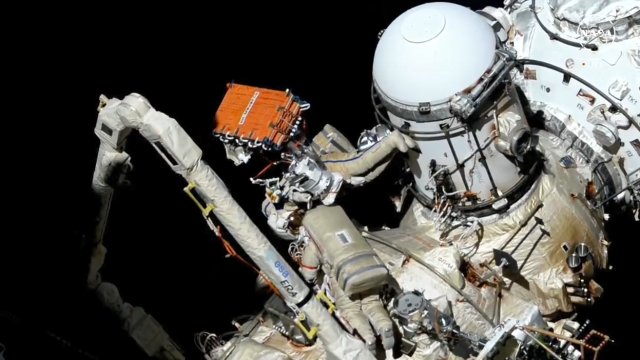A bubble of coolant leaked out of a radiator attached to the International Space Station (ISS), jeopardizing an ongoing spacewalk by two Russian cosmonauts on Wednesday.
Cosmonauts Oleg Kononenko and Nikolai Chub exited the ISS and began their spacewalk at 1:49 p.m. ET. During the nearly eight hour spacewalk, the pair were inspecting a leak on a backup radiator on Russia’s Nauka laboratory module when residual coolant spewed out of the leak site, NASA wrote in a blog post.
The spacewalking cosmonauts were told to leave the area immediately out of fear for their safety, although NASA later revealed that the coolant did not get onto their suits. Before reentering through the Poisk airlock, the cosmonauts wiped down their suits and tools “to look for signs of coolant and wipe off any coolant as necessary,” NASA wrote.
“The cosmonauts also wiped down their suits and tools as usual after repressurisation to further reduce the introduction of trace contaminants into the space station environment,” the space agency added. “Additional filtration will then be used inside the space station in order to quickly scrub the atmosphere of any remaining traces of contaminant.”
On October 9, flight controllers at NASA’s mission control noticed that the backup radiator on Russia’s Nauka module was leaking coolant into low Earth orbit. Although the main radiator was still working normally and did not disrupt ISS operations, the leak resulted in the delay of two NASA spacewalks as engineers reviewed the data of the incident.
During Wednesday’s spacewalk, the cosmonauts installed a synthetic radar communications system and released a nanosatellite to test solar sail technology. The two cosmonauts were also supposed to isolate the leaking radiator but they were not able to due to the bubble of leaking coolant that spilled out of it.
The backup radiator was delivered to the ISS in 2010 and transferred to the Nauka module during a Roscosmos spacewalk in April. The module itself was added to the ISS in July 2021.
This is the third time a leak has sprung from Russian hardware attached to the ISS. In December 2022, ground teams observed a fountain of particles pouring out from a Soyuz spacecraft docked to the ISS. At the time, Russia attributed the first leak to a micrometeorite strike on the spacecraft. Shortly after, however, a Russian Progress 82 freighter docked to the ISS also began leaking coolant in February. Russia’s space agency again claimed that it was caused by an external impact, but now with the third incident, it is hard not to question the integrity of the hardware itself.
So far, NASA is claiming that it is business as usual on board the ISS. One of its delayed spacewalks was rescheduled to October 30, and NASA astronauts Loral O’Hara and Jasmin Moghbeli are still set to venture outside the space station despite the cosmonauts’ spacewalk mishap.
